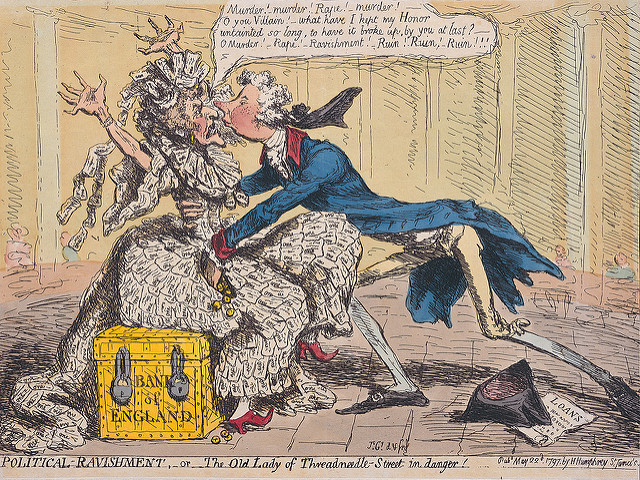The Bank of England has come in for much criticism in recent times from a wide range of different groups, from small investors to politicians. Having been late to identify a return of much higher inflation and its policymakers’ admitting flaws in their own forecasting tools, last week a Lord’s committee claimed the bank had not been held accountable for their role in maintaining a stable financial environment. Is this feedback fair and how should we define the role of a central bank? How did they become such an important cog in our financial world? Simon Durling, from Santander Asset Management, shares his thoughts in this week’s State of Play.
Key highlights from this week’s State of Play
- What is a central bank?
- Accountability
- Market update
What is a central bank?
The Bank of England (BoE) cannot claim to be the oldest central bank in history (that honour goes to the Riksens Ständers Bank in Sweden), but its formation, influence and structure helped forge the birth of an empire and the model on which most of the central banks formed in this era were based. Towards the end of the seventeenth century, England had suffered a heavy defeat to France, the dominant naval power at the time, at the Battle of Beachy Head (1690). King William III and Queen Mary’s government needed to rebuild both the economy and, importantly, their navy to compete on the world stage. However, they were short on funds and had, what in today’s terms would be described as a poor credit rating, making borrowing almost impossible. Charles Montagu, the 1st Earl of Halifax, using an idea first proposed by British economist William Paterson three years before, founded in 1694 ‘The Governor and Company of the Bank of England’ to raise share capital and lend it to the UK Government in return for an 8% interest charge. The UK Government would guarantee the loan and any national debt through the Tonnage Act by raising taxes on shipping and alcohol.1
 Bank of England and Royal Exchange, Central London
Bank of England and Royal Exchange, Central London
It began as a private bank that would act as a banker to the UK government. The original Royal Charter of 1694, granted by King William and Queen Mary, explained that the Bank was founded to ‘promote the public good and benefit of our people’. The BoE opened for business on 1 August 1694 in temporary accommodation in the Mercers’ Hall in Cheapside, London. It had a staff of just 17 clerks and two gatekeepers. It raised £1.2 million in just 12 days, using half of the capital raised to rebuild the naval fleet. The additional economic benefit was the massive industrial effort required in establishing new ironworks to make more nails and the advances required in agriculture to help feed the quadrupled size of the navy helped grow the economy and, with it, the nation’s wealth and influence.1
Old Lady of Threadneedle Street
The BoE moved to its current location on Threadneedle Street in 1734, standing on an island site covering 3.5 acres surrounded by huge walls. The underground vault, which contains more space than a large office block, holds the gold reserves of the UK and many other countries, making it one of the largest stocks of gold bullion in the world. It is referred to as the ‘The Old lady of Threadneedle Street’ which was taken from a cartoon by James Gillray in 1734 depicting the then Prime Minister, William Pitt the Younger, wooing an old lady – who represents the BoE, but his true intention is to get his hands on the BoE’s gold reserves, illustrated by the gold coins in her pocket and the money chest on which she is firmly sat. It was privately owned by stockholders from its foundation in 1694 until it was nationalised in 1946 by the Labour government which was elected at the end of the Second World War. The main building is not open to the public for obvious security reasons, given the amount of gold held under lock and key! 2

A detail from Political Ravishment or The Old Lady of Threadneedle Street in Danger, by James Gillray (British Museum). Source: Bank of England.
Monetary Policy Committee (MPC)
When Tony Blair became Prime Minister in 1997, his then Chancellor of the Exchequer, Gordon Brown, announced that the BoE would be granted operational independence over the setting of monetary policy. Under the terms of the Bank of England Act 1998, the Bank’s Monetary Policy Committee (MPC) was given sole responsibility for setting interest rates to meet the UK government’s inflation target, which at the time was 2.5%. Later in December 2003, the inflation target was changed from the Retail Prices Index (RPI) to track the Consumer Prices Index (CPI) target of 2% to bring the UK in line with the European Union.
The MPC is made up of nine members – the Governor, the three Deputy Governors for Monetary Policy, Financial Stability and Markets and Banking, the BoE’s Chief Economist and four external members appointed directly by the Chancellor of the Exchequer. External members are appointed to make sure that the MPC benefits from thinking and expertise from outside of the BoE. A representative from HM Treasury also sits with the MPC at its meetings. The Treasury representative can discuss policy issues but is not allowed to vote. They are there to make sure that the MPC is fully briefed on fiscal policy developments and other aspects of the UK Government’s economic policies and that the Chancellor is kept fully informed about monetary policy.2
Accountability
The former Chairman of the Federal Reserve, Ben Bernanke, was appointed by the Bank of England in July this year to lead an independent review of their forecast modelling and the errors that have been identified during the last two years or so. Having been late to spot the return of much higher inflation, which peaked at 11.1% in October last year, the MPC has been playing catch-up, subsequently increasing rates in 14 consecutive meetings until pausing in September. Eventually, rising prices have slowed, although they are currently at 4.6%, more than twice their target of 2%.3
The Lords’ economic affairs committee is calling for significant changes to make the Bank more accountable to match the substantial changes and widening of its powers and objectives in the 25 years since it was made independent setter of UK interest rates pegged to an inflation target. They describe a ‘democratic deficit’ in parliamentary scrutiny of the Bank of England, claiming the current oversight of their work has not been adapted sufficiently enough to reflect the changing responsibilities and recommend that their role and how they are held to account is reviewed every 5 years. A representative from the bank said: “We’d like to thank the Lords EAC for this report and will be giving the recommendations careful consideration. We’ll respond formally in due course.” Members of the parliamentary committee worry about their much wider role, which now includes subjects such as climate change, diverting their attention from the primary objectives and purpose and creating potential (political) conflicts of interest.4
So, is this feedback fair and are they right to call for changes? The purpose of this weekly update is not to provide specific opinions or critiques of politicians, policies or leaders. However, let me share some observations of the bank’s role, the market backdrop and lessons from the past. Firstly, I think it is important to acknowledge the extraordinary events of the last three years. The global pandemic and its financial consequences have been well documented. The return of inflation and the late response from central banks have triggered a sharp increase in interest rates to bring down rising prices. With the benefit of hindsight, policymakers were wrong to deem the return of inflation temporary and they have since acknowledged failures in the forecasting tools they have been using, hence the appointment of Ben Bernanke to review them.
One of their additional responsibilities is stated on their website - ‘Following the financial crisis of 2007-08, the Government decided to bring in massive regulatory reform. Reforms to the financial system came through the Financial Services Act (2012) which announced an independent Financial Policy Committee (FPC) created at the Bank of England and its new prudential regulator, the Prudential Regulation Authority, created as a subsidiary of the Bank, with new responsibilities for supervising financial market infrastructure providers.’ This additional responsibility has broadly worked well since then and arguably has been severely tested during the global pandemic, directly after last year’s infamous ‘mini budget’ and earlier this year when the banking crisis brought back some unhappy memories of 2007 and 2008. However, as with all regulations and policies, they need to be reviewed, updated and changed as our financial world evolves. While each of us may have a differing opinion about the recent success of the bank, given the evidence under stress in recent times, the important custodian of our financial stability remains as important as ever to help guide the politicians we choose to navigate economic challenges and changes. What seems sensible is to regularly review their role and remit and whether politicians have sufficient line of sight to the actions taken by the bank to hold them to account. We will wait to see what formal response the bank provides to the Lord’s committee and whether this brings about changes reflecting the recommendations in their report.
Market update
Following the shortened week in US stock markets due to the Thanksgiving holiday, the US market registered another small rise, making it 4 positive weeks on the bounce, taking it very close to the peak in July and within touching distance of the start of 2022’s high of 4,700.5 Investors are now faced with a balance between the good news of inflation falling combined with what looks like a peak in interest rates and the expectation that both economic growth is expected to slow and the possibility of a recession looming at some point in 2024. Much of this year’s stock market returns have come from a small batch of companies often referred to as the ‘magnificent seven’ (Apple, Nvidia, Tesla etc…). Will there be an opportunity for investors to widen their scope to the broader market given the uncertain outlook? It’s hard to tell. This will heavily depend on whether central banks have slammed on the brakes to slow the economy or have enacted the full-blown ‘emergency stop’, catapulting the economy into recession.
If future economic data does turn sour, the expectation will be the prospect of interest rates being cut sooner than anticipated by market participants, leading to a fall in bond yields. When yields fall, bond values rise, cushioning the blow of declining share prices if the outlook becomes gloomy. This relationship between shares and bonds (especially during 2022), called correlation, was temporally positive. Put simply, when share prices fell bond values also fell. More recently, this has returned to a conventional negative relationship (share prices fall – bond prices rise), helping diversify portfolios and smooth the investment ride. The remaining weeks of this year will reveal both the strength of the economic slowdown and the continued trend of rising prices, triggering the answers we all seek.
The value of seeking guidance and advice
It is important to seek advice and guidance from a professional financial adviser who can help to explain how to build an appropriate financial plan to match your time horizons, financial ambitions, and risk comfort. If you already have a plan in place, or have already invested, it is important to allocate time to review this to ensure this remains on track and appropriate for your needs.

Investing can feel complex and overwhelming, but our educational insights can help you cut through the noise. Learn more about the Principles of Investing here.
Note: Data as at 30 November 2023. 1Bank of England, 31 January 2023. 2Bank of England, 10 January 2019. 3The Times, 27 November 2023. 4Financial Times, 27 November 2023. 5Investing.com, 27 November 2023.
Important information
For retail distribution.
This document has been approved and issued by Santander Asset Management UK Limited (SAM UK). This document is for information purposes only and does not constitute an offer or solicitation to buy or sell any securities or other financial instruments, or to provide investment advice or services. Opinions expressed within this document, if any, are current opinions as of the date stated and do not constitute investment or any other advice; the views are subject to change and do not necessarily reflect the views of Santander Asset Management as a whole or any part thereof. While we try and take every care over the information in this document, we cannot accept any responsibility for mistakes and missing information that may be presented.
The value of investments and any income is not guaranteed and can go down as well as up and may be affected by exchange rate fluctuations. This means that an investor may not get back the amount invested. Past performance is not a guide to future performance.
All information is sourced, issued, and approved by Santander Asset Management UK Limited (Company Registration No. SC106669). Registered in Scotland at 287 St Vincent Street, Glasgow G2 5NB, United Kingdom. Authorised and regulated by the FCA. FCA registered number 122491. You can check this on the Financial Services Register by visiting the FCA’s website www.fca.org.uk/register.
Santander and the flame logo are registered trademarks.www.santanderassetmanagement.co.uk





